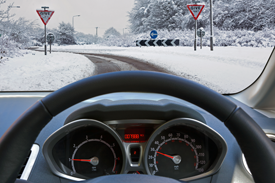Driving in snow
Is your journey really that urgent or important? When venturing out in the snow only make essential journeys. 
It's better to be warm and safe at home than to be involved in an accident or stuck in a car overnight. If you must venture out on the roads ensure that you and your car are equipped to deal with the cold snap.
Before you set out
- Check the local and national weather forecasts.
- Listen to local and national radio for travel information.
- Plan your journey.
- Make sure you are equipped with warm clothes, food and boots, torch and a shovel.
- Tell someone at your destination what time you expect to arrive.
- Take a mobile phone with you for contact. Remember to pull over and park safely before using it.
Clear vision
- Make sure all windows and mirrors are completely clear before you set off:
- Use an ice scraper or de-icer.
- Never use hot water as this can cause damage the temperature difference could crack or deform your windscreen.
- Clear front and rear lights, door mirrors, number plates, and if you have them fitted, your front and rear parking cameras.
- Make sure all windows are demisted and not just a small area.
- It is also worth checking that the windscreen wipers aren’t stuck to the screen:
- If they are you can rip off the rubber blades when you turn them on.
- Clear the roof of your car of snow.
Leave plenty of braking room
- If the car in front suddenly has to stop will you have time to react?
- It can take ten times longer to stop in icy or snowy conditions than on a dry road.
- Drive slowly, allowing extra room to slow down and stop.
- A good tip is to be around 20 seconds behind the car in front. Check you are far enough away:
- Watch for the car in front to pass an object, for example a sign or lamp post.
- Count how many seconds go by before you pass the same object.
- If it’s less than 20 seconds slow down and leave extra space.
Driving in icy or snowy conditions
- Use the highest gear possible to avoid wheel spin.
- Manoeuvre gently, avoiding harsh braking and acceleration.
- To brake on ice or snow without locking your wheels, get into a low gear earlier than normal, allow your speed to fall and use the brake pedal gently.
- If you start to skid, ease off the accelerator, but do not brake suddenly.
If you get into trouble
- Stop somewhere safe or ask a passenger to make the call. Do not use a mobile phone while driving.
- On a motorway, it is best to use a roadside emergency telephone, because the breakdown / emergency services will be able to locate you easily. If you have a mobile phone, make sure you give them the number of the closest marker post to you on the hard shoulder.
- Abandoned vehicles can hold up rescue vehicles and snow ploughs. To ensure that the road is cleared as quickly as possible, stay with your vehicle until help arrives.
- If you have to leave your vehicle to get help, make sure other drivers can see you.
